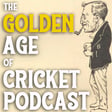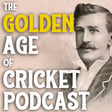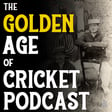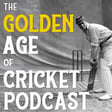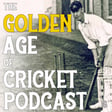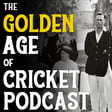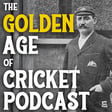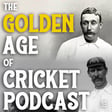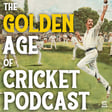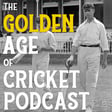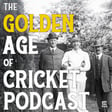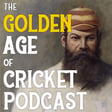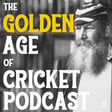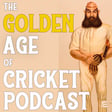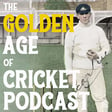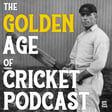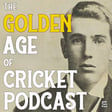Monty Noble's Cricket Career Overview
00:00:08
Speaker
Welcome to part two of the podcast on Monty Noble with his biographer Peter Lloyd. My name is Tom Ford. Be sure to listen to part one focusing on Monty's family and early life and his rise to cricket fame.
Calming the Crowd: 1903-04 Series Incident
00:00:26
Speaker
I want to press you on something you mentioned about Monty during the 1903-04 series against England. During the infamous run out of Clem Hill at the SCG in December, the crowd was irate at the umpire's decision and began to boo, forcing Monty and his counterpart Plum Warner onto the field to calm them down.
00:00:48
Speaker
You write, quote, noble, not always a crowd favorite, in part because of his apparent aloofness, remained calm and measured. You then quote a local Sydney paper which says, quote, the crowd do not like their Monty too well. Can you expand
Monty's Leadership Style: Popularity and Strategy
00:01:05
Speaker
on this? Why did Monty have a difficult relationship with cricket crowds? Well, Monty certainly wasn't a crowd favorite like Trump or McCartney, for example.
00:01:15
Speaker
He had an aloofness about him, but it wasn't a disdain for the public. He knew how important satisfied spectators were ensuring the health of cricket. I think his dilemma was that whatever match he was engaged in, especially once he'd assumed the captaincy, whether for his club or state or country, or even in the muck-up games on Easter excursions, his level of intensity was at fever pitch and he was totally immersed in the moment, plotting the next move to gain an advantage.
00:01:45
Speaker
He didn't come across to the general observer as a spontaneous cricketer. He could seize a game by the neck when in the mood. As I said, Jesse Davis bemoaned the fact that those occasions of pure mayhem with Battle Ball weren't seen often enough. But he was more than capable of doing just that. But he seemed to hold himself in check, reserving his more adventurous mode for when it really was needed. Maybe the crowd sensed that reluctance to dominate.
00:02:13
Speaker
He was the darling of the home crowd at Hampton Park because the local spectators knew what to expect. And more often than not, Paddington with monitor at the helm was a very formidable side. So I think it's more the exuberance of the Trumpers and the McCartney's that gains the public gaze. Somebody who's cerebral, perhaps more cerebral has less affinity with the masses.
00:02:40
Speaker
As a captain, Monty experienced both the highs and lows in the top job.
Challenges of Captaincy and Demotion
00:02:45
Speaker
He was captain during the home series against the visiting MCC of 1903-04, of which Pawn Warner's team won back the Ashes. And then he was the victorious captain over England in 1909, which turned out to be his swung song as an international player. Where do you personally think he ranks amongst Australian captains?
00:03:08
Speaker
Look, it was only when I was researching Monty and was notified, thanks to Rick Sisons, about a biography of Arthur Sims written by Alan Mitchell, 84 Not Out. Sims was a mighty successful New Zealand industrialist and a cricket fanatic, his sponsor, or at least guaranteed funding of several tours of New Zealand by Australian cricketers. Over the years, Sims became close friends with many Australian cricketers, including Frank Laver and Monty Noble, whom he held in very high regard.
00:03:38
Speaker
However, he, Sims, through his biographer, made the interesting point that when the Australian team came to New Zealand in 1905 en route to England again, Arthur was captain of Canterbury, and also of New Zealand. Until they reached England, the Australians were led by Noble.
00:03:57
Speaker
later on to be regarded as one of the greatest of captains but at this period there was a feeling that Noble was not quite tough enough for the Englishmen and as it turned out Joe Darling joined the team in London and took over against them. So to all intents and purposes
00:04:16
Speaker
Noble appeared to take this
Monty Noble's Leadership Perception
00:04:18
Speaker
demotion, if you like, on the chin. However, he must have been bitterly disappointed, especially as Darling had basically retired from first-class cricket well before the Ashes tour. I'm with Sims, though. Although Monty was an experienced captain, an excellent strategist and well-liked by those under his charge, he was still relatively young.
00:04:38
Speaker
In 1903-04, when Hugh Trumbull was dragooned to come out of retirement, cajoled to come out of retirement to help the Australian cause against the great enemy, the Eleven voted to retain Noble as Skipper throughout the series, despite Trumbull having had previous useful captaincy experience at the highest level.
00:04:56
Speaker
But in 1905, Noble probably still lacked a gritty inner soul, if I could express it that way. The fact that he was highly popular with opposition players, though, says something of his style of leadership. The decision of the Australian players to go with Darling, who, according to some reports, was the last member of the 1905 squad chosen, backfired, as it turned out. Joe was able to avoid defeat on many occasions on tour, but in the final timeless test,
00:05:24
Speaker
he couldn't ward off defeat. Whether Noble would have done better is uncertain. By 1907-08 and 1909 he was a tougher individual and a more rounded leader. He was successful despite being confronted by the extraneous distractions of a boardroom which says a lot.
00:05:44
Speaker
My opinion for what it's worth is that Australia's two best test captains, and they were chalk and cheese in many ways, in the way they deported themselves, for example, were Monty and Ian Chappell.
00:05:57
Speaker
Food for thought.
Life After Cricket: Financial Struggles
00:05:58
Speaker
It seems that Monty gave up cricket, certainly international and regular first-class cricket, following the 1909 Ashes Tour for a few reasons, but the main one was financial. The reduction of player payments following the Australian cricket boards assuming control of tours meant that those who weren't well off couldn't rely on cricket wages alone. He was a trained dentist, but did he take his dentistry seriously?
00:06:27
Speaker
Well, Monty couldn't remain a modest bank teller with the English, Scottish and Australian bank when unable to obtain lead of absence for the southern tour of New South Wales in 1898-99. He was faced with the choice of full-time employment or cricket, and he chose the latter. The option of undertaking dentistry as a career was appealing because once qualified, he'd be his own man and could, as necessary, while away on tour, employ a locum. Of course, dentistry in the early 1900s
00:06:57
Speaker
was far from what the profession is today. Monty, like most others, essentially an apprentice learning on the job. In Monty's case, his master or his mentor, if you like, was Henry Peach, a dental entrepreneur and outspoken agitator for reform. Monty attended night courses and learnt the basic techniques of dentistry
00:07:19
Speaker
in monitored public clinics. He was serious about the work, but as his cricket cricket career became more demanding on his time, he was less in his private suite and more frequently traveling the country and the world and paying a locum in the order of two pounds a week for the privilege. Hard to establish a regular clientele under those circumstances. Nonetheless, he did maintain his registration with the New South Wales dental board throughout his life while moving premises on a regular basis.
00:07:49
Speaker
While he continued as a practicing dentist, he increasingly needed to supplement his income post-retirement from big cricket after the 1909 Ashes tour, although he did play, as you mentioned, in a few first-class matches after the Great War to help us to support the sport in its regeneration. He became an indent agent for all manner of products and services, and he used the various dental premises and his commercial addresses for these ventures.
00:08:19
Speaker
Interestingly, Monty never became a wealthy man, evident by the need following his death in 1940 for a group of friends and supporters, including Warwick Armstrong, to raise money to finance his son Rodney's university enrolment.
00:08:34
Speaker
As mentioned, the few years leading up to his retirement saw him have a very strained relationship with cricket officials, notably those of the New South Wales Cricket Association, and Monty was overlooked for many selected jobs because of it.
Bargaining and Relationships with Officials
00:08:50
Speaker
Can you elaborate on that point please?
00:08:53
Speaker
Well, this whole area is extremely complicated and I don't think I can do it justice in a brief discussion. The best second resource for extended coverage of all the dramatic circumstances can be found in the early chapters of Gideon Haig and David Fith's remarkable 2007 book, Inside Story.
00:09:12
Speaker
unlocking Australian cricket archives, a volume that wouldn't be published today given the nature of cricket Australia. And of course newspapers of the day and not just the sporting press gave the matter enormous coverage and for an extended period. The jury was out.
00:09:27
Speaker
probably remains out as to the rights and wrongs of the collective bargaining stance that Noble took. The bottom line, though, is that Noble suffered much more than any other single player for speaking out for the collective. He lost friends and significant opportunities to contribute to Australian cricket, both in the middle and in the boardroom. In the process, he made a lot of intractable enemies, many of whom, including Billy McAlone, were far less astute than Monty on all manner of cricket matters.
Cricket Achievements and Statistics
00:10:07
Speaker
Well, let's turn our attention now, Peter, to Monty's cricketing statistics. I'm just going to read through some of the numbers here. Feel free to jump in if you make any observations. Of course, Monty made his test debut in 1898 on the 1st of January, as you mentioned earlier, versus England at the MCG.
00:10:30
Speaker
essentially 12 seasons later in 1909 versus England at the Oval played his final test match. His first class career obviously lasted a lot longer first match during the 1893-94 season and his final first class match many many years later in 1919 and 1920 season where many of these golden age cricketers
00:10:58
Speaker
effectively came out of retirement or extended their career to help the post-war effort. Going through some of the numbers, so he played 42 test matches, he batted 73 times for 73 innings, he had seven not outs,
00:11:16
Speaker
scored just shy of 2000 runs, 1997. High score of 133. Interestingly just one test century. He scored 16 test 50s and his batting average was 30.25.
00:11:34
Speaker
On or at first class level he played 248 matches, 377 times at the batting wicket. He scored 13,975 runs with a high score of 284 with a batting average of 40.74.
00:11:54
Speaker
scored 37 first class centuries and 66 half centuries. On the bowling front in test cricket he took 121 wickets and gave away 7159
00:12:10
Speaker
runs across 71 bowling innings. His best bowling was 7 for 17 which we're going to touch on and best match figures which happened to be the same match 13 for 77 with a bowling average of 25.
00:12:26
Speaker
and his first class bowling figures he took 624 wickets best bowling innings 8 for 48. There are grade figures there which we can touch on
00:12:42
Speaker
I think perhaps you can talk to this point they're not as complete obviously as the test and first class figures simply for record keeping in the day so we have to assume or piece together many of his grade statistics but when we consider those numbers there are two things which jump out at me certainly from his test batting record and first is that he only scored one test century over those 42 matches
00:13:12
Speaker
And second, his conversion from 50 to 100 was quite low. So one century and 1650s. And when we compare it with his first class record, he was much more successful in converting two centuries because he had 37 first class centuries and 66 50s. What do you make of Monty's batting record? Well, look, I agree.
00:13:42
Speaker
Statistics don't lie, but they can blur particulars. Often Nürburg was placed in a situation where what was called for at the international level, and that of course met England overwhelmingly. He played a few tests against South Africa, was occupying the crease sometimes at the expense of accumulating runs. England's test bowlers during the golden age, particularly in England, were in the main and depended upon selection vagaries, which there were many.
00:14:11
Speaker
They were a cut above the average first-class trundler. Also, the added burden of long stints of bowling probably impacted on his batting to an extent. It'd be interesting to run the ruler over how often he passed the milestone figure of 50 runs, say, on those occasions when he bowled more than 30 overs in an innings. I'm sure Colin Klaus could give me a quick answer. I'll have to get back to you, I think, on that point, though. We have to take into account the fact that pictures weren't covered,
00:14:41
Speaker
which helped the bowling, detracted from the batting. Monty's overall career figures are not too dissimilar to many of the high ranking players who were batsmen alone. And similarly, his bowling figures were very similar to the top ranked bowlers who didn't necessarily have a batting acumen. So I think in total, even though it's
00:15:08
Speaker
easy to suggest that he could have perhaps extended some of his innings at test level to make the magic three-figure mark. I think very often was the case that the match conditions made it very difficult to confront bowlers who were highly talented. Not that the first-class bowlers in Australia weren't.
00:15:32
Speaker
And Monty did do very well in England under suspect conditions, batting conditions on occasions. You can tell by his record of 2000 runs in three of his Ashes tours, which is quite a phenomenal achievement. Yes, some of the better scores were obtained against county sites. The opportunity to
00:16:00
Speaker
entertain the crowds. I think in those county matches was something that Modi enjoyed. Test cricket was a very serious matter. So I understand what you're getting at. I agree. It all has to be taken in the context of conditions and the match moments.
00:16:20
Speaker
Looking at his bowling figures, his best test figure, as I mentioned earlier, was seven for 17, which is quite extraordinary. We occasionally see this figure come up in television graphics when they're talking about the great bowling figures over history. And he took 13 wickets for the match. What can you tell us about the circumstances of this particular test match?
00:16:45
Speaker
So the Melbourne test was over the 1st and 4th of January, 1902. It was a very rain affected affair. The pitch was described by all reports as a unplayable wicket. Australia were perilously placed after day one in its second innings on 5 for 48 after having been sent in by Archie McCrarrant. Both sides had been bundled out in the first innings for 122 and 61 respectively.
00:17:13
Speaker
and there were just 265 minutes of play on that first day, a Wednesday, during which the 25 wickets fell. Trumbull and Noble bowled unchanged for 15.4 overs, the necessary overs to dismantle England. Trumbull took the wickets of the first three batsmen in the order and Noble the remaining seven.
00:17:34
Speaker
Well-known Australian statistician Charles Davis flagged Noble's achievement of taking five of his seven wickets in the space of 12 balls as being the record for all test comers for 117 years of test cricket until beaten by a New Zealand Trent Bolt against Sri Lanka at Christchurch in 2018-19 when Trent took five wickets in 11 balls. So it was quite an aberration, that Monte performance.
00:18:02
Speaker
Darling then reversed the Australian batting order for its second inning, so while the Australian were five down for very little, the genuine batsman hadn't appeared on the scene. He was waiting until the wicket became more docile, under what he hoped would be bright sunshine and heat, and that's exactly what happened. Australia's revised lower order rallied, and the impressive total, given the circumstances,
00:18:26
Speaker
of 353 was reached with Reggie Duff, 104 on the boo in his second innings, but on the boo and Clem Hill. And this is an interesting fact. I know you'll be aware of this many wouldn't be Clem scored 99, which was the first such score in test history. They led the way. Then the heavens opened again and England faulted once more on day three being dismissed for 175, thereby losing the test by 229 runs.
00:18:56
Speaker
Noble, in the second innings, took six for 60 off 26 overs and tumbled four for 49 off 22.5 overs. Several other bowlers bowled a few overs for the Australians. A phenomenal effort, but very much helped by the conditions. Archie McLaren, the captain of England at the time, noted after the match that Noble has the gift of making the ball swerve away from the batsman or making the ball go with his arm, for instance,
00:19:25
Speaker
a ball which is hitting the off stump, when halfway on its journey will often miss it by a foot. Consequently, a batsman has to be careful in driving or playing out to this ball. I consider him, Noble, one of the greatest bowlers of all time.
00:19:42
Speaker
And this match in particular, Peter, is a real fascination of mine because I'm constantly enthralled by looking at these cricketing records, batting lineups from the Golden Age. And this is a perfect example of a captain forced to compete against the weather, the natural elements, so to speak. As you say, Darling had to
00:20:08
Speaker
legitimately reversed the batting order in an attempt for what was a horrible wicket to dry up and give his better batsman time to play on a better wicket and if you look at the Australians second innings as you say you have Trumpa and Hill and Armstrong and I think Reggie Duff who scores his
00:20:30
Speaker
first century, all batting down the order. Possibly Duff scores it in the number nine position, I can't remember. I think number 10. To the modern observer looking at this, you might think this is odd, why is Victor Trumper batting so low? But it was all part of playing during this period before
00:20:51
Speaker
covered wickets and therefore there was a there was a real art in managing the elements as the captains had to do back then. The other amazing thing about this match as you mentioned and just doing my mathematics quickly you say 25 wickets on that first day extraordinary in itself but I think only
00:21:14
Speaker
what, five hours of play total? So those wickets must have just come one after the other. Really, really fascinating stuff. Just over four hours, Tom, in fact, yes. Wow. It reminds me a little of the most recent Brisbane test. Yes. Where conditions were totally unsuited to batting because the pitch was, its preparation was delayed because of weather.
Biographical Challenges and Accuracy
00:21:40
Speaker
The actual match itself was played under perfect skies, but
00:21:44
Speaker
the opportunity for the ground staff to prepare a pitch of suitable quality. The test cricket was impinged. Joe Darling wasn't the only one to attempt this strategy or to use the strategy. Noble himself did so. Don Bradman did so later at a time when covered wickets were becoming more prevalent.
00:22:09
Speaker
So I think the capacity to be flexible is an attribute of Captain C, which maybe is underutilized and underrecognized. Now test and first-class statistics are easily accessible, not just for Monty Noble, but for all cricketers largely. But what challenges exist for the biographer when faced with analyzing grade statistics?
00:22:36
Speaker
So cricket is, after all, as much a game of numbers as it is a spectacle. And the two major criticisms that I've had as a writer, as an author of biographies have come to me quickly after a book was read by two people from England who picked up statistical errors, minor statistical errors, but errors nevertheless. And when I mentioned these to Colin Clowes, who was
00:23:05
Speaker
My go-to guy for ensuring accuracy, Colin appreciated he'd made a mistake and he felt terrible about it. So we're at a situation where at grade level, given the circumstances of how cricket scoring was maintained, often with only one scorer, quite often a visiting side at grade level didn't provide a scorer. Quite often it was the home side's
00:23:35
Speaker
scorer who tabulated the statistics. These data had to be then submitted to the newspapers and to the cricketing authorities within a space of two or three days for publication and for record keeping. They were only acknowledged, well in the main they were only acknowledged if the secretary of the club signed off on them.
00:24:00
Speaker
The problem in the early days of Sydney cricket, Sydney grade cricket, and probably throughout Australia and perhaps in England as well, was that a variety of sources were used, a variety of reports are available. Sometimes there's a variation in the figures that have been printed. So in Monty's case, the season of 1899, 1900,
00:24:30
Speaker
is muddied by conflicting published accounts of the number of runs that were scored off his bowling. In fact, there's a variation of 15 runs. There's an agreement on the number of wickets he took that year, but there's an inconsistency among four or five publications, newspaper publications, where the aggregate run scored varies.
00:24:58
Speaker
Although that might seem very insignificant, it does have a bearing not only on that one particular season, but on his career overall. So we are fortunate, I suppose, to say that at first-class level, test level, it can be a guarantee. And we now know through prodigious scrutiny of information precisely what all first-class cricketers achieved in their careers, we have only
00:25:28
Speaker
a general sense of what the average grade cricketer did, but we often have a better appreciation of the more longstanding grade cricketers, but we can't guarantee accuracy. In Monty's case, there is this infuriating small number of runs and aberration which will go, will remain unresolved forever.
00:25:56
Speaker
But in the biography, there is an appendix which talks about Monty's extended grade career and it was all anecdote at the beginning explaining the differences for that one particular season. It also touches on his brother's grade statistics. Is that right? Yes, it does. Ted Batted involved a little for a much shorter time. There's no doubt about the accuracy of his figures.
00:26:27
Speaker
He also played, as I said, five first-class matches, didn't have an outstanding episode in New Zealand, but was a very good player, very good clubman. In fact, he helped Paddington on two occasions to the great premiership by his own deeds as a batsman. What did Monty do during cricket retirement? Could you touch on the books he produced and how helpful they were to your research?
Post-Retirement Contributions to Cricket
00:26:55
Speaker
So Monty's legacy as an aspirational figure is dependent on both his on-field deeds and his work post-retirement, as you say. He became a renowned broadcaster, respected analyst, prolific author, and travelling journalist. He had untrammeled and immediate access to many dressing rooms, a fact that other reporters wouldn't have had. He was a would-be federal politician, eventually a club representative at the State Association, and a long-time publicly endorsed trustee at the SCG.
00:27:26
Speaker
Apart from his failed political career, which never really got off the ground, I think he was a little naive about what was expected of him, he gave his all to each of the other endeavors. In terms of authorship, all his five books, well, four books and a booklet really, sold well both in Australia and England, running into several editions. He wrote concisely about deeds on the field and took the opportunity to express strong views on the running of the game in Australia. Sometimes the views that he expressed
00:27:56
Speaker
were enhanced by sub-editorial titling which perhaps provided more of a
00:28:02
Speaker
criticized version of what he actually said. His magnum opus was obviously the 1926 discourse entitled The Game's The Thing. In the biography, I label this book unwieldy, because although what he writes is always pertinent, his subject matter tended over time to veer from topic to topic with little organizational precision.
00:28:27
Speaker
In fact, the book could have well done with some significant editing, but I get the impression, though, that Monty would never have allowed such interference as he no doubt perceived it to happen. His books were valuable resources for me, if not used directly, at least in terms of their tone, and that was very helpful.
Influence as an SCG Trustee
00:28:46
Speaker
In retirement, Monty was the first member elected trustee of the Sydney Cricket Ground. How significant was his role and how did he view its importance?
00:28:58
Speaker
I think Rodney Cavalier would be the go-to guy on this whole matter, Tom. He and Jeff Armstrong are well into a history of the SCG trustees, and hopefully later this year that book will appear. It'll be a bestseller, I'm sure. Monty was the first and the only during his lifetime popularly elected trustee. The trust itself wasn't known as a trust. It was just a group of trustees until well after Monty's period.
00:29:24
Speaker
He became a pivotal party to the ground in all manner of matters, in terms of maintenance, future planning activities. He was the go-to guy. He genuinely improved the way that the ground old ground was used for the benefit of the members and the public. He was at the forefront of the building of the stand that was named after him, nine years following his death.
00:29:48
Speaker
His legacy really knows no bounds. It was totally appropriate that the structure and its modern replacement be named after him. When the stand was unveiled, the name was unveiled in 1949, the Governor General, William McKell, a very good friend of Monty's did the honors. Rodney Cavalier could tell you all about how long and drawn out with the discussions about the naming of the stand during the 1940s and how he, Rodney, was determined
00:30:18
Speaker
as a long-term chairman of the SCG Trust, not to let that happen during his stewardship. When another new structure was being built, namely the Victor Trumpistan, Rodney didn't allow any debate on that at all, or very limited debate, I should say, and it was a no-brainer. Rodney would suggest that it should have been a no-brainer as well in the noble period. For those looking in and around Sydney, what noble monuments exist?
00:30:49
Speaker
Well, in short, not very many, apart from the MO Noble standard of the SCG, Sydney's inner west, inner east rather, inner east, Wallara Municipal Council recently unveiled a footpath plaque adjacent to the gates of what was until 1931 Hampton Park, since then known as Trumpa Park. That memorial is a stone's throw away from where Monty and his mother and sometimes a brother or two lived in Cambridge Street. The only other small plaque
00:31:19
Speaker
which bears his name and details, is included in the Driver Avenue Walk of Honor path in Moore Park, just outside the SCG. And that park was unveiled in 2001. That's it. And finally, Peter, what do you think Monty would have thought about the modern game?
Modern Cricket Views and Advocacy
00:31:42
Speaker
This was a good question to finish on, Tom. Because Monty was a very modern thinker.
00:31:48
Speaker
He would have been an enthusiast of the shorter form of the game, or shorter forms of the game, as long as they didn't impact negatively on test cricket.
00:31:56
Speaker
He would have been a real handful as a player across the three forms, given his versatility and all round skills. And he would have been especially pleased to know that the modern day elite cricketer is well remunerated for his or her efforts. As an aside, Monty considered that one of his daughters had real aptitude as a batsman, much more so than Rodney. However, he would have wanted more financial support to be made available for grassroots cricket.
00:32:25
Speaker
He would have been amazed, I think, at the covering of wickets and the need for artificial lighting. Even universal scoreboards would have been an eye-opener. Often in England, in the dusk, scoreboards didn't exist during his touring. And he would have been bemused, I think, about white and pink cricket balls. I'm not sure whether he would have been okay with that development.
00:32:50
Speaker
Well, Peter Lloyd, it's been wonderful learning all of this about the great MA Noble. I thank you for your time and energy in joining this podcast. And once again, congratulations on the recent publication, Monty Noble, Cricutting Nobility. Perhaps we could do this again, talking about Warren Bardsley one day soon. That would be delightful, Tom. I'd be very pleased to be part of that program as well.
00:33:16
Speaker
That's all for today's episode, thanks for listening, remember to favourite or subscribe to the podcast so you'll never miss an episode. My name is Tom Ford, until next time, it's bye for now.

